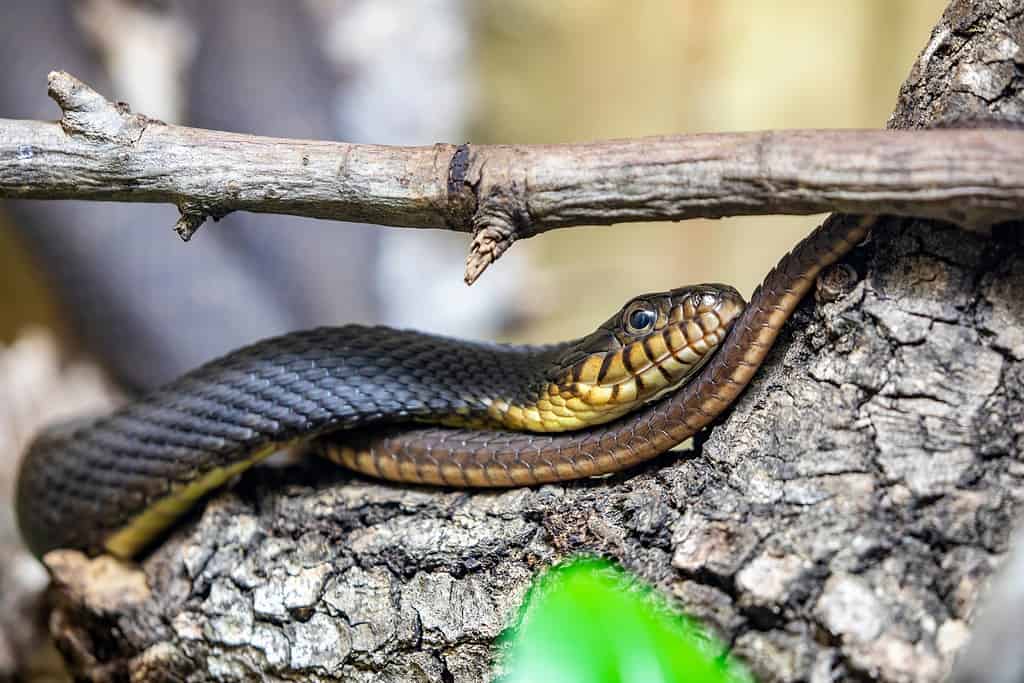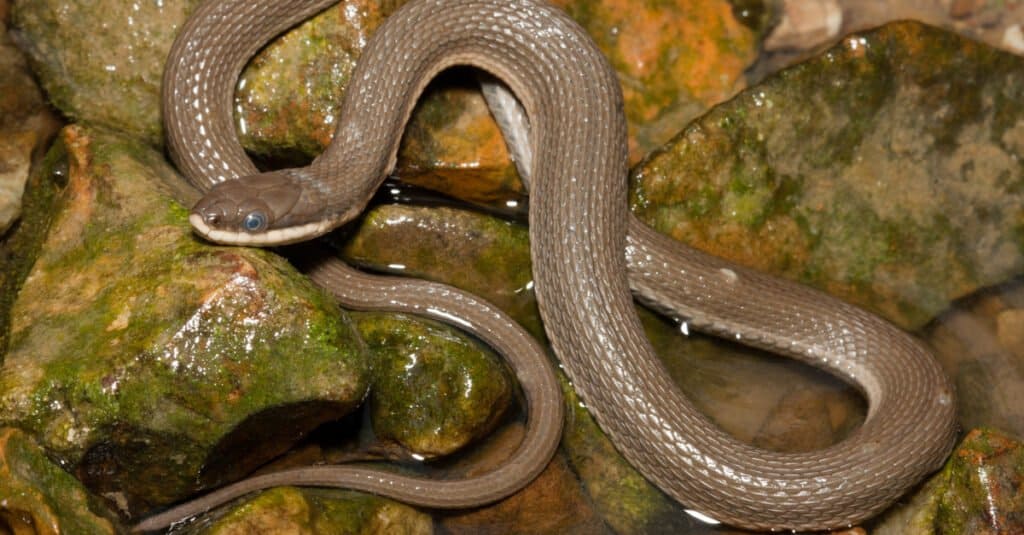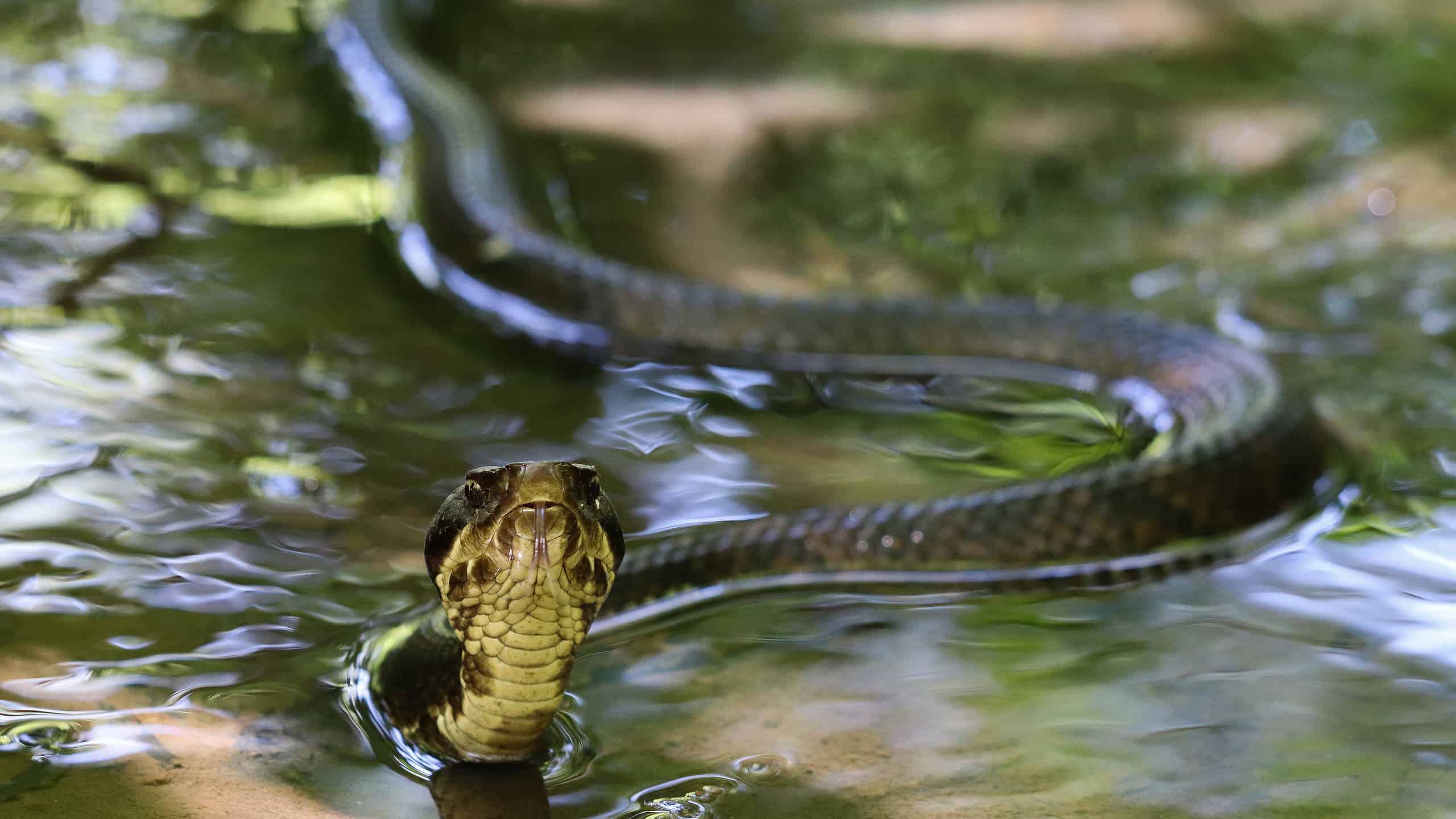If you are a person that is fascinated by nature, then you probably love the uniqueness of water snakes in Maryland. The way these creatures swim is quite fascinating. Water snakes are worth learning about, whether you search for them in water sources or simply read about them.

Most water snakes in Maryland are either aquatic or semi-aquatic. This means that the water snakes will stay close to water habitats. They will usually either actively swim or bask near the shore. Finding some water snakes far from water habitats is possible, but it’s not likely.
Below are three of the most common Maryland water snakes!
1. Northern / Common Water Snake
This is the most common water snake in Maryland. Its scientific name is Nerodia sipedon.
The snake is large and quite conspicuous. It’s also one of the 27 snake subspecies native to Maryland.

The northern water snake is the most common species in Maryland.
The northern water snake has the following characteristics:
- They measure 24 to 55 inches in length as adults.
- The snakes are pale gray or dark brown. They have black to reddish-brown bands too.
- Older adults tend to be darker. They get very dark and assume an almost black-to-dark brown color.
- Females are larger than males. They also have the most vivid colors of all water snake species.
General Behavior
Generally, northern water snakes are the most common in Maryland. These snakes are slow-moving. They prefer to rest in ponds, lakes, streams, marshes, vernal pools, and slow rivers. You will likely spot the snakes basking on logs and rocks near water sources, especially near the shallow ends.
Every time they feel threatened, they escape into the water. However, the snakes will defend themselves when attacked. They release a bad-smelling musk from their glands at the tail base. This is followed by flattening the belly before they attack.
While the water snakes have no venom, they deliver a powerful bite that can leave quite an impact. Their saliva has a mild anticoagulant which is responsible for minor bleeding. As such, the injury caused by the snake’s bite appears more serious.
Such defense mechanisms are essential for the water snake’s survival. Common predators include raccoons, foxes, turtles, opossums, birds, and snakes.
The northern water snake has stable populations in Maryland. Even so, they still are at risk of habitat loss. Humans also kill them out of fear, even though they are not a threat. As for their distribution around Maryland, you can find them all over the state.
Feeding
Usually, the snakes feed at any time of day. However, when temperatures get too low, they restrict their feeding to warm hours only. These snakes primarily feed on fish and amphibians.
Typically, water snakes are social animals. They coil together when basking on stones in fall and spring. However, as the days get hotter, they become solitary.
You may find them overhanging on branches or cattail stems.
Bleeding
After hibernation, the mating season is in March and late April. Females come out and give birth to live young ones between August and September.
Between 12 to 36 young snakes are in a litter. The snakes can live up to nine years in captivity. This lifespan is significantly shorter in the wild due to numerous predators.
How are the Snakes Conserved?
Human attacks are the biggest threat to Maryland’s common water snakes. Many people kill them out of fear.
The Nongame and Endangered Species conservation act protects the northern water snake. It is also responsible for other native snakes in Maryland. Any killing of snakes, selling, or possession/breeding is prohibited. One must obtain a permit from the Department of Natural Resources to handle these snakes. Maryland residents need a captive reptile and amphibian permit to keep the snakes. The permit allows the breeding and sale of non-native amphibians and reptiles.
2. Plain-Bellied Water Snakes
This famous water snake‘s scientific name is Nerodia erythrogaster. They are usually seen around the eastern shore of Maryland’s water bodies.

Plain-bellied water snakes are common around the eastern shore of Maryland’s water bodies.
©Danny Ye/Shutterstock.com
Common characteristics of this snake include:
- Adults measure 20 to 40 inches in length. They also have a thick body.
- They come in solid colors varying from olive, gray, brown, and black.
- Their underside is unmarked, usually plain yellow or red in color.
- Other common names include copper belly, yellow belly, blotched water snake, and red belly snake.
General Behavior
This snake spends most of its time in or near water. You can easily spot them in ponds, lakes, floodplains, rivers, and wetlands. They also hunt in water and are excellent swimmers.
However, it’s the only species of water snake in Maryland that spends a lot of time on land. Don’t be surprised to find it deep in the woodlands during hot, humid seasons.
Plain-bellied water snakes of Maryland feed on terrestrial and aquatic prey. They often eat crayfish and amphibians, such as salamanders and frogs.
Unlike most other water snakes that chase and hunt their prey, the plain-bellied do not. They lay in an ambush waiting for the prey before they attack.
Breeding
Their females also give birth to live young. The birthing period is between August and September. But the breeding occurs from April to June. Females mate with multiple males during this season.
Litters average 18 babies. However, there have been cases of 55 young snakes in a litter. The snakes give birth via parthenogenesis, a process of asexual reproduction. The young develop from unfertilized embryos. No sperm from the male snakes is needed.
Like the previous water snake species, the plain-bellied snakes have a powerful bite. They also produce a foul-smelling musk when captured.
Their biggest threat or predators include hawks, large-mouthed bass, egrets, and larger snakes.
3. The Queen Snake
The queen snake is the third water snake in Maryland. It is scientifically called Regina septemvittata.
It is ranked as an uncommon snake species in Maryland. Though not federally ranked as endangered, some states consider it endangered.

The queen water snake is not common in Maryland.
©Nathan A Shepard/Shutterstock.com
The common characteristics of this water snake include the following:
- Adults range from 24 to 36 inches in length.
- They can be olive green or drab brown with light stripes on the side.
- The underside is either yellow or tan. Uniquely, they have four lines running the length of their belly.
General Behavior
Unlike the other water snake species, the queen snakes do not venture far from the water’s edge. You will likely find them in streams and rivers with rocky bottoms. However, the water sources must be clear and flowing so they don’t thrive in dirty or contaminated waters.
The queen snake is prone to water loss through evaporation. This is because of its high permeability. Consequently, these snakes thrive around water areas only.
Queen snakes are not as secretive as other water snakes in Maryland. You can easily spot them basking on rocks and vegetation around the water bank. They also love hanging on nearby trees.
Usually, they take refuge on the rocks along the water banks. Some people are lucky enough to catch the queen snakes swimming.
Feeding
They are specialist predators that feed on specific foods, such as crayfish. They prefer newly molted crayfish because they are softer and do not have pincers.
Queen snakes hunt by probing under rocks and submerged items. These are likely to be places where crayfish hide. When attacked, the snakes first hide under the water’s surface. They also swim along the shoreline for a while and then reappear.
If a predator successfully captures them, they flatten and produce a foul-smelling musk. This odor comes from their tail glands. They also differ from other water snakes in Maryland because they won’t bite.
Worth Noting
- Maryland may be a small state compared to many. However, its diversity, especially in nature, makes it unique and fascinating. Its 15 species of snakes is evidence.
- All of these snakes are important in the natural fauna composition of the region.
- The area’s different categories of snake species include venomous and nonvenomous.
- Another common category of snakes is water snakes.
- There are mainly three different species of water snakes in the state, and they are non-venomous. The snakes attack only to defend themselves when provoked. Their unique characteristics make them a wonder to behold.
- When next you come across one of these three water snake species, do not provoke them. After all, they are not venomous. Appreciate their beauty and move on.
Summary of Water Snakes in Maryland
| Common Name | Scientific Name | Size |
|---|---|---|
| Plain-Bellied Water Snakes | Nerodia erythrogaster. | 20 to 40 inches |
| The Queen Snake | Regina septemvittata. | 24 to 36 inches |
| Northern Water Snake | Nerodia sipedon. | 24 to 55 inches |
Discover the "Monster" Snake 5X Bigger than an Anaconda
Every day A-Z Animals sends out some of the most incredible facts in the world from our free newsletter. Want to discover the 10 most beautiful snakes in the world, a "snake island" where you're never more than 3 feet from danger, or a "monster" snake 5X larger than an anaconda? Then sign up right now and you'll start receiving our daily newsletter absolutely free.
Thank you for reading! Have some feedback for us? Contact the AZ Animals editorial team.








